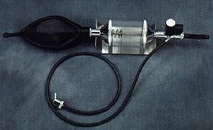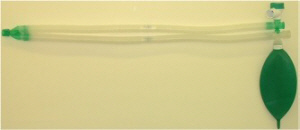
Vetrica Policies – Vetrica Never Uses Re-breathing Circuits
This is an anaesthetic gas circuit. It is what actually delivers the anaesthetic gases to the patient. The circuit shown here is called a “To-And-Fro”, and is a type of circuit called a re-breather, so called because the patient re-breathes its own exhaled air. The clear plastic canister (shown empty) is filled with soda-lime, which the animal breathes through into the black rubber bag. The function of the soda-lime is to absorb carbon dioxide present in the patient’s exhaled breath, allowing the remaining gases to be re-used. This reduces the total quantity of anaesthetic gases required very considerably, hence reducing the cost. However, there are many problems with these types of circuits.
- Soda-lime creates a resistance to an animal’s breathing out. All anaesthetic regimes depress respiration, and adding to gas flow resistance compounds this problem.
- Soda-lime is caustic, and is responsible for many of the coughs that animals develop after an anaesthetic.
- if the soda-lime is not replenished in time, the patient can breathe back a dangerous quantity of carbon dioxide.
- If the canister is not completely full, exhaled breath can flow over the top of it, rather than through, again enabling dangerous quantities of carbon dioxide to be inhaled.
- Crucially, the composition of the gas entering the patient is never the same as that being delivered by the anaesthetic machine. The anaesthetist has to guess at what is happening. This is not good enough for our patients. While there are significant cost savings to be made by using a re-breather, we believe that anaesthetic safety is compromised with its use.
Vetrica does not use re-breathing circuits.

This picture shows a circuit called a Parallel Lack. This circuit does not allow the re-breathing of exhaled breath by the patient. Gas flows into the patient along one tube, and out along a different tube. This parallel, wide-bore tube system makes the resistance to air flow as low as possible. Low resistance to air flow minimises the risk to the patient from depressed respiration due to anaesthesia. There is no soda-lime to breathe through, or to irritate the airways, and crucially, the settings of the anaesthetic machine accurately match the composition of the gas being breathed in by the patient.
HAVE A QUESTION OR WANT TO FIND US Click here

